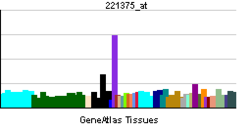- OR1G1
-
Olfactory receptor, family 1, subfamily G, member 1 Identifiers Symbols OR1G1; OR17-130; OR17-209; OR1G2 External IDs MGI: 3648768 HomoloGene: 105311 GeneCards: OR1G1 Gene Gene Ontology Molecular function • receptor activity
• olfactory receptor activityCellular component • plasma membrane
• integral to membraneBiological process • signal transduction
• sensory perception of smell
• response to stimulusSources: Amigo / QuickGO RNA expression pattern 
More reference expression data Orthologs Species Human Mouse Entrez 8390 545417 Ensembl ENSG00000183024 ENSMUSG00000049094 UniProt P47890 n/a RefSeq (mRNA) NM_003555 XM_001000818 RefSeq (protein) NP_003546 XP_001000818 Location (UCSC) Chr 17:
3.03 – 3.03 MbChr 2:
37.09 – 37.09 MbPubMed search [1] [2] Olfactory receptor 1G1 is a protein that in humans is encoded by the OR1G1 gene.[1][2][3]
Olfactory receptors interact with odorant molecules in the nose, to initiate a neuronal response that triggers the perception of a smell. The olfactory receptor proteins are members of a large family of G-protein-coupled receptors (GPCR) arising from single coding-exon genes. Olfactory receptors share a 7-transmembrane domain structure with many neurotransmitter and hormone receptors and are responsible for the recognition and G protein-mediated transduction of odorant signals. The olfactory receptor gene family is the largest in the genome. The nomenclature assigned to the olfactory receptor genes and proteins for this organism is independent of other organisms.[3]
Contents
See also
References
- ^ Ben-Arie N, Lancet D, Taylor C, Khen M, Walker N, Ledbetter DH, Carrozzo R, Patel K et al. (Jul 1994). "Olfactory receptor gene cluster on human chromosome 17: possible duplication of an ancestral receptor repertoire". Hum Mol Genet 3 (2): 229–235. doi:10.1093/hmg/3.2.229. PMID 8004088.
- ^ Rouquier S, Taviaux S, Trask BJ, Brand-Arpon V, van den Engh G, Demaille J, Giorgi D (Mar 1998). "Distribution of olfactory receptor genes in the human genome". Nat Genet 18 (3): 243–250. doi:10.1038/ng0398-243. PMID 9500546.
- ^ a b "Entrez Gene: OR1G1 olfactory receptor, family 1, subfamily G, member 1". http://www.ncbi.nlm.nih.gov/sites/entrez?Db=gene&Cmd=ShowDetailView&TermToSearch=8390.
Further reading
- Glusman G, Sosinsky A, Ben-Asher E et al. (2000). "Sequence, structure, and evolution of a complete human olfactory receptor gene cluster". Genomics 63 (2): 227–245. doi:10.1006/geno.1999.6030. PMID 10673334.
- Matarazzo V, Zsürger N, Guillemot JC et al. (2003). "Porcine odorant-binding protein selectively binds to a human olfactory receptor". Chem. Senses 27 (8): 691–701. doi:10.1093/chemse/27.8.691. PMID 12379593.
- Strausberg RL, Feingold EA, Grouse LH et al. (2003). "Generation and initial analysis of more than 15,000 full-length human and mouse cDNA sequences". Proc. Natl. Acad. Sci. U.S.A. 99 (26): 16899–16903. doi:10.1073/pnas.242603899. PMC 139241. PMID 12477932. http://www.pubmedcentral.nih.gov/articlerender.fcgi?tool=pmcentrez&artid=139241.
- Malnic B, Godfrey PA, Buck LB (2004). "The human olfactory receptor gene family". Proc. Natl. Acad. Sci. U.S.A. 101 (8): 2584–2589. doi:10.1073/pnas.0307882100. PMC 356993. PMID 14983052. http://www.pubmedcentral.nih.gov/articlerender.fcgi?tool=pmcentrez&artid=356993.
- Gerhard DS, Wagner L, Feingold EA et al. (2004). "The status, quality, and expansion of the NIH full-length cDNA project: the Mammalian Gene Collection (MGC)". Genome Res. 14 (10B): 2121–2127. doi:10.1101/gr.2596504. PMC 528928. PMID 15489334. http://www.pubmedcentral.nih.gov/articlerender.fcgi?tool=pmcentrez&artid=528928.
External links
This article incorporates text from the United States National Library of Medicine, which is in the public domain.
Class II
(tetrapod specific receptors)Family 1Family 2A1 · A2 · A4 · A5 · A7 · A12 · A14 · A25 · A42 · AE1 · AG1 · AG2 · AJ1 · AK2 · AP1 · AT4 · B2 · B3 · B6 · B8 · B11 · C1 · C3 · D2 · D3 · F1 · F2 · G2 · G3 · G6 · H1 · H2 · J1 · J2 · J3 · K2 · L2 · L3 · L5 · L8 · L13 · M2 · M3 · M4 · M5 · M7 · S2 · T1 · T2 · T3 · T4 · T5 · T6 · T8 · T10 · T11 · T12 · T27 · T29 · T33 · T34 · T35 · V1 · V2 · W1 · W3 · W5 · Y1 · Z1
Family 3Family 4Family 5Family 6Family 7Family 8Family 9Family 10Family 11Family 12Family 13Categories:- Human proteins
- Transmembrane receptor stubs
- G protein coupled receptors
Wikimedia Foundation. 2010.
